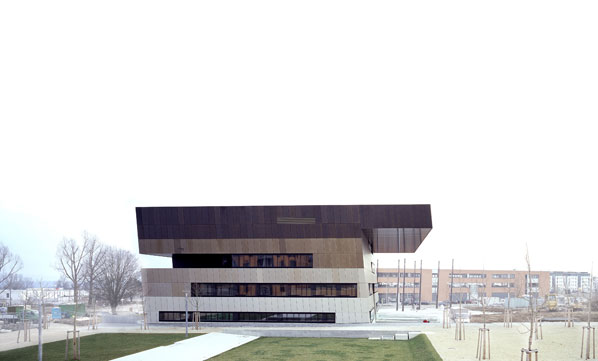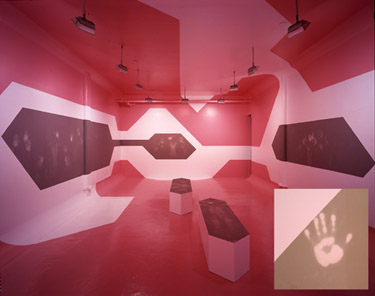Jurgen Mayer Interview with Baunetz
 Wednesday, June 30, 2010 at 1:30AM
Wednesday, June 30, 2010 at 1:30AM An architect who designs buildings and furniture, and who on top is also an artist represented by a renowned Berlin gallery. How do all these disparate strands fit together?
For me they are all very closely related. What is particularly interesting is to consider everyday life, which is articulated in several criteria. In architecture the procedures are more complex, simply because there are more people involved. With regard to smaller dimensions, on the other hand, it is easy to find out what one actually wants to say, to search for different formulations, it is far simpler to experiment. The themes are actually almost always the same.
So what can transcend the boundaries of a particular genre?
I think primarily output with what I would call functional and material potential. What opportunities does a particular material offer? What happens if I remove it from its usual context and place it in another? How can I deliberately emply material "wrongly" ? How can familiar ways of familiar ways of viewing things be questioned, consciously trigger confusion? These are topics that I find exciting and my addressing them is one explanation for why, for example, the polyurethane cover used for the refectory in Karlsruhe actually comes from the field of roofing, or why with regard to the Bisazza furniture lots of people like the fact that something soft emerges from what are actually hard materials.

Do not precisely these two cases illustrate a difference between the two criteria? With regard to furniture, which perhaps has something of mini-pieces of architecture about it, anything goes. As far as a building, which stands on a campus like a piece of furniture, is concerned, you are quickly accused of infringing strict principles relating to the just use of materials.
The just use of materials and innovation with materials – where is the borderline here? And who is to say what is better or more valuable? We aimed to create an elastic space with continuous surfaces; that was the basic idea behind the design, which we initially pursued without actually making a final decision on a specific material. Keeping to the budget we were given would have meant a box with a few windows, so we had to be ruthless in our calculations. Concrete and steel were ruled out, which is why it was a wooden structure. An economical and highly progressive system involving pre-fabricated elements: Hollow cases, panels of laminated timber planks and particularly sturdy plywood, all of which is then coated with that layer of plastic. We got the maximum out of the materials so as to create the space and atmosphere we wanted with them. We met our targets in terms of construction costs and time, and it’s easy to look after as well, which in the Baden-Württemberg region can be of greater significance than elsewhere.

(ada 1)
Yes, and several others as well. Whenever I look back at the last ten years of “production”, certain things keep coming up and networking with something new. Something we perhaps researched at a totally different time, and under quite different conditions, produces the answer to a question relating to a quite different project. And it’s right: I believe there has to be more to architecture than just looking at it once, there has to be something to discover, that we as observers should find be addressed on several levels. I at least aim to produce architecture that cries out to be looked at a second time.
...like the municipal building in Ostfildern, which at first sight you don’t realize tilts a few degrees...
Exactly, or our buildings for Danfoss Universe, which are not to do with ballooning, like in current free shapes, but with precisely the opposite, with a vacuum, with shrinking and condensing. For me it is an expression of quality if architecture has various levels of accessibility, if its appearance seduces, but on a deeper level there is also “material for discourse”, in other words matter for theoretical, intellectual discussion.

(Stadthaus in Ostfildern)
You have been searching for and promoting intellectual discourse for years now as a teacher. Your company is becoming bigger and bigger and New York is not exactly the closest of places. Nonetheless since 2004, each fall, you have been teaching at Columbia University, and prior to that you were visiting professor in Harvard and at the AA in London. What do you get from it, apart from it looking good on your CV, and lots of flight miles?
The time I spend in New York is always at the cost of the company, there’s no doubt about that. The pressure really builds up then and it’s becoming increasingly difficult to organize everything. On the other hand it is enjoyable and valuable ‘input’ for me personally to discuss certain questions a group and really get to the bottom of them. You only get that in a college, not in everyday office life. It’s fascinating to see how the students develop and discuss their ideas with them, as a teacher it’s of enormous benefit. Which is why all the effort is worthwhile.
A glance at the Columbia events calendar is enough to turn you green with envy. In just a single week there is discussion between Mark Wigley and Charles Jencks and three lectures by ‘Foreign Office Architects’. In the following week the picture is much the same.
It really is a luxury I’ll admit. Since Mark Wigley has been Dean there things have been really hotting up, there’s a lot going on right now.
“the expanded architect – away from it’s default settings” is the motto that appears in large letters on the start page.
On the Internet I discovered the sentence: “Jürgen Mayer H. designs suburban railroad carriages, collects preprints and designs bed linen”. Two of these activities are pretty accurate, but the one in the middle is a bit perplexing: What in the world would prompt anyone to collect preprints? What are they anyway?
They are data security patterns, in other words the sort of multi-leaf forms that courier services use. When somebody sends us something they have to declare its value on the front, where the address is. This information, however, is not meant to be seen by everyone. How expensive the thing was is of no concern to the person delivering it. These forms have several layers and on the various copies the patterns, which are always a jumble of figures or letters, can conceal certain information.
How do you collect something like that? And why?
I keep preprints like that whenever I get them and have actually specifically gone out in search of them. I now have over 300 different types. I contacted printers and the German Museum of Technology, and did a lot of research finding something out about how the principle came about. But hardly anyone really knows anything about it. The patterns are of interest to me as “strategic ornamentation”.
What does that mean? The patterns can be seen on your website, on bed linen and in an installation for the MoMA in San Francisco. But it can’t just be about decoration, about an alternative to floral and checked patterns?
No, the exciting thing about these patterns is that though they came about through pure expediency they are full of background symbolism: It’s to do with data monitoring, the appearance and disappearance of something. At an exhibition ten years ago in Chicago I designed a guest book that had data storage patterns, and treated them with temperature-sensitive print. Anything anybody wrote in it was initially invisible, but through the effect of heat, for example the body heat of a hand, emerged from the patterns and became legible. If you let go of the page, the writing disappeared again – appropriate for the coming and going of the guests in the gallery.
We become less critical as we get older...
Of course. When you are young you think you have to rebel against such like – against Swabia, and its small and medium-sized enterprises, which I would lovingly have swapped for the highly intellectual environment of an academic family in an exciting big city. Fortunately, however, at some stage you realize why you became who you are. How much support you actually got at home or precisely the liberation from what seems to be a preordained destiny, makes you particularly strong. Nowadays I appreciate all of that and admire my parents’ openness and ability to learn. They come to my exhibitions, look at my architecture and address things that initially are totally new. They always say that being “confronted” with things like that are an enrichment for them. Actually it just occurs to me that when I was a student I did Winnenden a huge favor.
You did? What was it? An early building?
 Jurgen Mayer in
Jurgen Mayer in  Interview,
Interview,  Transcript
Transcript 

